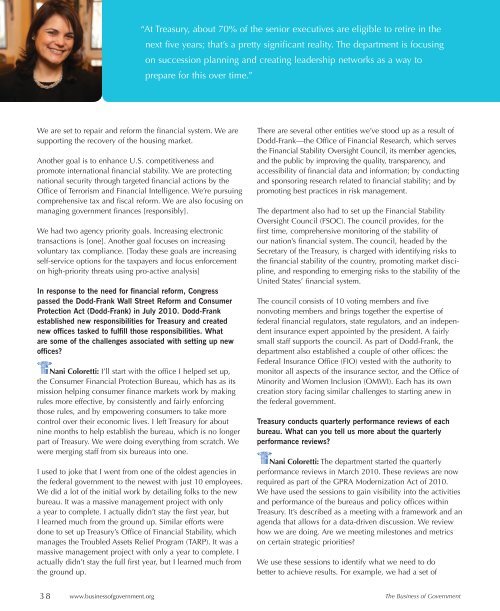1hmPUyl
1hmPUyl
1hmPUyl
You also want an ePaper? Increase the reach of your titles
YUMPU automatically turns print PDFs into web optimized ePapers that Google loves.
“At Treasury, about 70% of the senior executives are eligible to retire in the<br />
next five years; that’s a pretty significant reality. The department is focusing<br />
on succession planning and creating leadership networks as a way to<br />
prepare for this over time.”<br />
We are set to repair and reform the financial system. We are<br />
supporting the recovery of the housing market.<br />
Another goal is to enhance U.S. competitiveness and<br />
promote international financial stability. We are protecting<br />
national security through targeted financial actions by the<br />
Office of Terrorism and Financial Intelligence. We’re pursuing<br />
comprehensive tax and fiscal reform. We are also focusing on<br />
managing government finances [responsibly].<br />
We had two agency priority goals. Increasing electronic<br />
transactions is [one]. Another goal focuses on increasing<br />
voluntary tax compliance. [Today these goals are increasing<br />
self-service options for the taxpayers and focus enforcement<br />
on high-priority threats using pro-active analysis]<br />
In response to the need for financial reform, Congress<br />
passed the Dodd-Frank Wall Street Reform and Consumer<br />
Protection Act (Dodd-Frank) in July 2010. Dodd-Frank<br />
established new responsibilities for Treasury and created<br />
new offices tasked to fulfill those responsibilities. What<br />
are some of the challenges associated with setting up new<br />
offices?<br />
Nani Coloretti: I’ll start with the office I helped set up,<br />
the Consumer Financial Protection Bureau, which has as its<br />
mission helping consumer finance markets work by making<br />
rules more effective, by consistently and fairly enforcing<br />
those rules, and by empowering consumers to take more<br />
control over their economic lives. I left Treasury for about<br />
nine months to help establish the bureau, which is no longer<br />
part of Treasury. We were doing everything from scratch. We<br />
were merging staff from six bureaus into one.<br />
I used to joke that I went from one of the oldest agencies in<br />
the federal government to the newest with just 10 employees.<br />
We did a lot of the initial work by detailing folks to the new<br />
bureau. It was a massive management project with only<br />
a year to complete. I actually didn’t stay the first year, but<br />
I learned much from the ground up. Similar efforts were<br />
done to set up Treasury’s Office of Financial Stability, which<br />
manages the Troubled Assets Relief Program (TARP). It was a<br />
massive management project with only a year to complete. I<br />
actually didn’t stay the full first year, but I learned much from<br />
the ground up.<br />
There are several other entities we’ve stood up as a result of<br />
Dodd-Frank—the Office of Financial Research, which serves<br />
the Financial Stability Oversight Council, its member agencies,<br />
and the public by improving the quality, transparency, and<br />
accessibility of financial data and information; by conducting<br />
and sponsoring research related to financial stability; and by<br />
promoting best practices in risk management.<br />
The department also had to set up the Financial Stability<br />
Oversight Council (FSOC). The council provides, for the<br />
first time, comprehensive monitoring of the stability of<br />
our nation’s financial system. The council, headed by the<br />
Secretary of the Treasury, is charged with identifying risks to<br />
the financial stability of the country, promoting market discipline,<br />
and responding to emerging risks to the stability of the<br />
United States’ financial system.<br />
The council consists of 10 voting members and five<br />
nonvoting members and brings together the expertise of<br />
federal financial regulators, state regulators, and an independent<br />
insurance expert appointed by the president. A fairly<br />
small staff supports the council. As part of Dodd-Frank, the<br />
department also established a couple of other offices: the<br />
Federal Insurance Office (FIO) vested with the authority to<br />
monitor all aspects of the insurance sector, and the Office of<br />
Minority and Women Inclusion (OMWI). Each has its own<br />
creation story facing similar challenges to starting anew in<br />
the federal government.<br />
Treasury conducts quarterly performance reviews of each<br />
bureau. What can you tell us more about the quarterly<br />
performance reviews?<br />
Nani Coloretti: The department started the quarterly<br />
performance reviews in March 2010. These reviews are now<br />
required as part of the GPRA Modernization Act of 2010.<br />
We have used the sessions to gain visibility into the activities<br />
and performance of the bureaus and policy offices within<br />
Treasury. It’s described as a meeting with a framework and an<br />
agenda that allows for a data-driven discussion. We review<br />
how we are doing. Are we meeting milestones and metrics<br />
on certain strategic priorities?<br />
We use these sessions to identify what we need to do<br />
better to achieve results. For example, we had a set of<br />
38<br />
www.businessofgovernment.org<br />
The Business of Government


